Karigane-ya, publisher
After a not-too-lengthy search, I manage to find the shop. I had been told it was just opposite the famous Denzuin temple in the Koishikawa district, but I actually walk right by it once before turning back and deciphering the large sign in front: 'Karigane-ya - Books'. The elderly man sorting a pile of yellow jacketed books in the shop doesn't seem to understand my strange Japanese at first, but after a minute he catches on to what I am after and directs me to some stairs leading up towards the workshops on the second floor. As I pick my way carefully up the very narrow steps, he looks curiously after me, just as though he'd never seen a foreigner before ....
When I reach the top, I find myself on a small landing onto which two rooms open, a large one at the front of the building, and a smaller one towards the rear. I stand there for a moment, uncertain which way to turn, and one of the men working in the front room beckons me to enter. Stepping through the doorway into the tatami room, about 12 mats in size, I see that four men, woodblock printmakers, are working here, their low benches all facing in the same direction, with the windows on their left hand. One of the older men says something to me in a quick burst of guttural speech. I can understand nothing. What language is this? Does he have marbles in his mouth? This is nothing like the Japanese I have studied for so many agonizing hours. But of course, why should I have expected my 'textbook learning' to have much relevance here, in a Shitamachi workshop full of tough old craftsmen? When he realizes that I cannot understand, he turns away and returns to his printing, tossing off some remark that brings a guffaw from the others. I stand hesitantly, unsure of how to proceed.
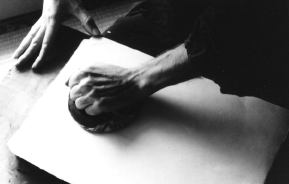 One of the men is younger than the others, still
only a teenager. He gets up from his working position and moves to
the corner of the room where a small brazier stands, and proceeds to
make tea for everybody. When he has served the other three, he
gestures for me to sit down beside him, and offers me a cup. I assume
from his age and his tea-making chores that he is an apprentice here,
and it turns out that this is so, for to my relief I can understand
some of what he says. He speaks to me slowly and carefully, and we
establish communication. In another month he will have been here two
full years, and he is eagerly awaiting the coming New Year holiday,
for with the turn of the year another apprentice will be joining the
group, and it will no longer fall to my new-found friend to make tea,
run for tobacco, clean the workshop, and spend all those endless
hours crouched over his mortar grinding pigments to the required
fineness.
One of the men is younger than the others, still
only a teenager. He gets up from his working position and moves to
the corner of the room where a small brazier stands, and proceeds to
make tea for everybody. When he has served the other three, he
gestures for me to sit down beside him, and offers me a cup. I assume
from his age and his tea-making chores that he is an apprentice here,
and it turns out that this is so, for to my relief I can understand
some of what he says. He speaks to me slowly and carefully, and we
establish communication. In another month he will have been here two
full years, and he is eagerly awaiting the coming New Year holiday,
for with the turn of the year another apprentice will be joining the
group, and it will no longer fall to my new-found friend to make tea,
run for tobacco, clean the workshop, and spend all those endless
hours crouched over his mortar grinding pigments to the required
fineness.
His apprenticeship will not be over then, far from it, as he will spend about another eight years learning his trade before taking his position as an independent worker. He is happy here, although somewhat frustrated in the work he is allowed to do. Today he is printing a stack of simple paper wrappers for a new novel being published, and he looks longingly at the work on the master's bench, a multi-coloured print of a courtesan in dazzling kimono. He knows he could do a good job of that one, if he were only allowed to try ...
When the other men see us enjoying our conversation, they relax and open up a bit. I start to get the hang of their workmen's speech, and the next few hours passes quickly. The room is jammed with the paraphernalia of the woodblock printer's trade. Carved cherry blocks are leaning against every wall, the low tables and boxes next to each bench are cluttered with crusted brushes, pots of pigment, and crumpled colour samples, and hanging from a series of strings stretched across one end of the room are dozens of drying prints. It turns out that I have not picked a particularly good time to visit. The approaching New Year season is one of the busy times of the year for the traditional bookseller, with many publications being issued then, and these men are busy. Under pressure from the proprietor (the old man I met downstairs?) the master printer up here has promised perhaps more than his crew can deliver, and there are some long days coming up ...
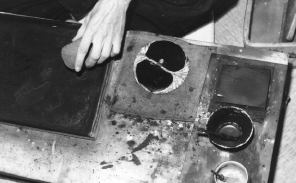 As we talk, the work continues apace. One of the
printers comes to the bottom of his paper stack, flips it over,
changes the block for one of another colour, puts a fresh pot of
pigment in place, and starts again. I make a mental note of the time,
and when he gets to the bottom again, calculate that it has taken 28
minutes. When I ask, he tells me that this is a standard run of 200
sheets. Eight seconds a sheet. (I'd be embarrassed to tell you how
long it would take me, so please don't ask!)
As we talk, the work continues apace. One of the
printers comes to the bottom of his paper stack, flips it over,
changes the block for one of another colour, puts a fresh pot of
pigment in place, and starts again. I make a mental note of the time,
and when he gets to the bottom again, calculate that it has taken 28
minutes. When I ask, he tells me that this is a standard run of 200
sheets. Eight seconds a sheet. (I'd be embarrassed to tell you how
long it would take me, so please don't ask!)
Another of the men is working stripped to the waist, even on this chilly winter day. He is printing a 'tsubushi', a wide area of solid colour, and on thick paper this is hard work. If the baren is not applied with full pressure across the entire area of the paper, the colour will be weak in places, and the print rejected. The huge golden carp climbing up the blue waterfall tattooed on his back is shiny with sweat, the muscles on his arms and chest bulge with the effort, and his contributions to the conversation are limited to the occasional grunted interjection.
At one point one of the men asks me about my purpose in coming here, and I explain that I have come to see Inoue-san the carver. In my involvement with the printing crew here, I have almost forgotten about that other workshop across the landing, and the young apprentice now takes me through to introduce me. The windows of this room face south, but as there is no sunshine today a lamp stands by each of the three benches throwing soft light over the work in progress. These are the carvers, the men who produced those woodblocks that are being so vigorously utilized in the other room.
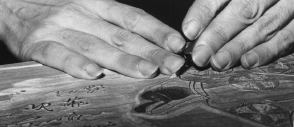 As we enter, two of the three men look up. A
middle aged man sits nearest the door, and next is a young boy who
could be the twin of my apprentice friend. Behind them, head bowed so
low over his bench that his nose practically touches the block, is
the man I have come to see today, Inoue ('ee-no-oo-eh') Shinshichiro,
master Ukiyo-e carver. The carvers' benches stand higher than those
of the printers in the other room, and are sloped slightly toward the
workers, while the printers' are sloped away. Inoue-san's left elbow
rests on the polished desk surface, the hand lying open on the
woodblock, the middle finger extended, acting as a guide for the
knife blade inching its way through the wood. He is oblivious to our
presence, and we say nothing to disturb him, but merely stand and
wait for him to pause.
As we enter, two of the three men look up. A
middle aged man sits nearest the door, and next is a young boy who
could be the twin of my apprentice friend. Behind them, head bowed so
low over his bench that his nose practically touches the block, is
the man I have come to see today, Inoue ('ee-no-oo-eh') Shinshichiro,
master Ukiyo-e carver. The carvers' benches stand higher than those
of the printers in the other room, and are sloped slightly toward the
workers, while the printers' are sloped away. Inoue-san's left elbow
rests on the polished desk surface, the hand lying open on the
woodblock, the middle finger extended, acting as a guide for the
knife blade inching its way through the wood. He is oblivious to our
presence, and we say nothing to disturb him, but merely stand and
wait for him to pause.
The block he is carving is of typical size, about 280 by 400mm, but the design on its surface seems a bit unusual. The block has been divided into two areas, and each carries a standing figure in kimono, bordered by an outline. This is not to be a single sheet print, but a leaf from a book. This block carries two pages from the book, and after carving is finished they will be printed together across a single sheet of paper, which will then be folded to put the images back to back, and sewn together with other similar sheets into the complete book form.
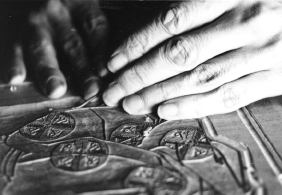 The printer's apprentice tells me about the book.
They have been working on it for nearly two years now (among other
projects), having started sometime early the previous year. It is a
collection of poetry of special interest at the New Year season, and
the carving and printing should have been finished some time ago, and
the trimmed sheets sent downstairs to the women who do the binding.
The book contains 50 of these double sheets, and Inoue-san is now
working on the final page. As soon as he has finished the faces, the
lettering, and a few other delicate places, he will pass the block
over to the other carvers for finishing up. This is standard
procedure, with the most experienced carver doing the 'kashira-bori'
('head carving'), and the younger men doing the 'do-bori' ('body
carving'). There are almost no wood chips lying around Inoue-san's
bench, as his work is on the millimeter scale, but the rest of the
room is littered with the chips sent flying by the other workers'
chisels.
The printer's apprentice tells me about the book.
They have been working on it for nearly two years now (among other
projects), having started sometime early the previous year. It is a
collection of poetry of special interest at the New Year season, and
the carving and printing should have been finished some time ago, and
the trimmed sheets sent downstairs to the women who do the binding.
The book contains 50 of these double sheets, and Inoue-san is now
working on the final page. As soon as he has finished the faces, the
lettering, and a few other delicate places, he will pass the block
over to the other carvers for finishing up. This is standard
procedure, with the most experienced carver doing the 'kashira-bori'
('head carving'), and the younger men doing the 'do-bori' ('body
carving'). There are almost no wood chips lying around Inoue-san's
bench, as his work is on the millimeter scale, but the rest of the
room is littered with the chips sent flying by the other workers'
chisels.
At last he stops carving, squints for a moment at the tip of his knife, and then turns his body sideways. I now notice a small oval wooden bucket sitting on the floor next to his cushion. Resting on a small wooden board perched over the water is a dun-coloured sharpening stone, and Inoue-san now moistens this with a bit of rag tied to a stick, and starts sharpening his blade. His motions are difficult to describe in words. The stone is placed in a crossways position in front of him. One elbow rests on a knee, and acts as a pivot point for the forearm holding the blade, which is swept over the stone from side to side so rapidly that I see only a blur. It takes only a few seconds to restore the edge of the steel, and he swivels back to his previous position. Another, smaller stone sits on a corner of the bench, and he now hones the blade on this hard surface. This takes longer, and both sides of the blade get the treatment, being rubbed hundreds of times down the length of the yellowish stone. After a while, he is satisfied with the result, and placing the knife to one side, sits back casually and takes out his pipe.
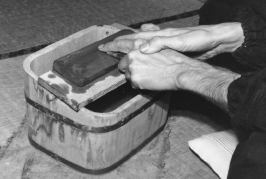 This is my cue, and I hesitantly introduce
myself. My friend the apprentice stays and helps with the
conversation, for again I find it difficult to understand. (My
ability to communicate with these craftsmen seems to be in inverse
proportion to their age.) Our discussion is not relaxed. Always I
have found it so when talking to carvers, who seem much more
reluctant to describe their work, sometimes almost secretive. The
contrast with the printers I have visited, who to a man have been
open, friendly and ready to offer advice, is quite marked. I am not
able to learn much beyond the fact that he started the craft as a
very young boy, spent about fifteen years as an apprentice, and over
the years gradually became respected in the business. I have seen his
work, and it is truly superb. He is one of a small group of men who
have set a new standard in woodblock carving. They are able to carve
hair lines so thin as to be almost invisible when printed, lines
which do not vary in their thickness by the slightest trace, and
kimono lines which flow across the page - the famous 'singing line',
the hallmark of good Ukiyo-e.
This is my cue, and I hesitantly introduce
myself. My friend the apprentice stays and helps with the
conversation, for again I find it difficult to understand. (My
ability to communicate with these craftsmen seems to be in inverse
proportion to their age.) Our discussion is not relaxed. Always I
have found it so when talking to carvers, who seem much more
reluctant to describe their work, sometimes almost secretive. The
contrast with the printers I have visited, who to a man have been
open, friendly and ready to offer advice, is quite marked. I am not
able to learn much beyond the fact that he started the craft as a
very young boy, spent about fifteen years as an apprentice, and over
the years gradually became respected in the business. I have seen his
work, and it is truly superb. He is one of a small group of men who
have set a new standard in woodblock carving. They are able to carve
hair lines so thin as to be almost invisible when printed, lines
which do not vary in their thickness by the slightest trace, and
kimono lines which flow across the page - the famous 'singing line',
the hallmark of good Ukiyo-e.
I ask him to tell me something of his thoughts on his work, but nothing comes of it. Just like most of his co-workers, he doesn't seem to be interested in much of anything other than the block on his desk. The book he is currently carving is very interesting to me, but when I try and elicit some of his thoughts on its artistic merits, I draw a blank. I have encountered this attitude time and again in visits with 'shokunin'. Their approach to this work is completely opposite to mine. I want to know everything. I want to do everything. They, on the other hand, have narrowed their focus to an extreme. Inoue-san is not even interested in seeing a copy of the finished book... But can he carve!
Inoue-san begins to get restless and I take the hint. He is eager to get back to work, so I close the conversation, but ask if I can stay for a while and watch. I get neither assent nor denial, but when my young printer friend heads back to his work, I remain seated off to one side, trying to make myself as inconspicuous as possible. I spend the rest of the afternoon sitting there, drinking in the scene - trying to fix in my mind the atmosphere of the room, the rhythmic tapping of the mallet wielded by the youngest carver, the scrape, scrape of the chisels, the gentle tearing sound made by Inoue-san's knife as he pares away at the wood. For me, learning what I have of woodblock printmaking by working essentially alone, a chance to hear the rhythm of this work is truly a gift. Later, back in my own workshop, I will try to recapture what I can of what I have seen here today.
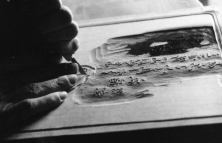 At last it is time to leave, and I make my
hesitant apologies for disturbing everybody. Back in the printers'
room lamps have now appeared, and it seems that everybody is settling
in for at least a few more hour's work. The goodbyes here are a
little warmer, and it is with real regret that I start down the
stairs. The shop is still open, with a few customers browsing through
some stacks of prints on display. These too I would love to see, but
time is short and I reluctantly leave and head for home.
At last it is time to leave, and I make my
hesitant apologies for disturbing everybody. Back in the printers'
room lamps have now appeared, and it seems that everybody is settling
in for at least a few more hour's work. The goodbyes here are a
little warmer, and it is with real regret that I start down the
stairs. The shop is still open, with a few customers browsing through
some stacks of prints on display. These too I would love to see, but
time is short and I reluctantly leave and head for home.
It has been a wonderful day. I have picked up dozens of useful tips and techniques, but probably more importantly, have 'recharged my batteries' through the contact with these craftsmen. I am eager to get back to my own work, and when I wake in the morning, I will head straight for my carving bench. Breakfast will have to wait. The memory of Inoue-san's delicate yet confidently carved lines will hang in front of my eyes as I pick up my own blade, gently press it into the wood, and start to work.
I carve the same images that Inoue-san carves, the same 100 poets, the same 100 poems. My first work did not even compare to the efforts of his young apprentice, but my 100th print ... Well, we'll see, won't we ...





